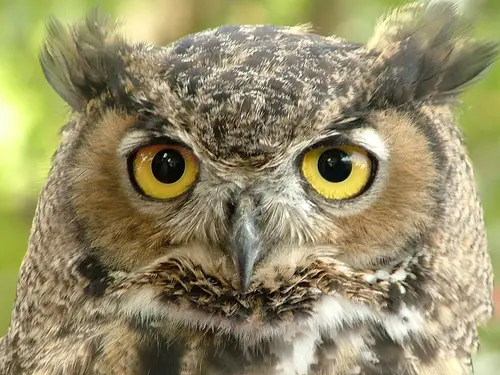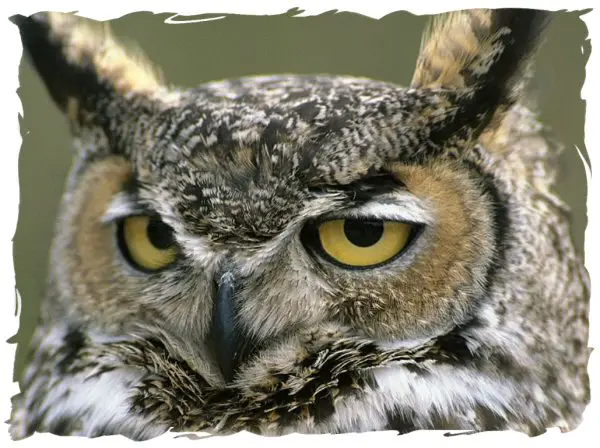This article takes you to the journey of great horned owl facts for kids that are not known to everyone. How many great horned owl facts have you gone through during your entire life? Well if you haven’t read enough then how about reading these owl facts that can give you an overview of these species. Great horned owl is actually the native bird of Americas. The extensive distribution of great horned owl all over the America makes it even more common. It is also known as the Tiger Owl. These birds have an extraordinary ability to camouflage themselves which makes them almost impossible to be identified in day time. One of the Amazing great horned owl facts are illustrated below.
Great Horned Owl Facts For Kids
- The length of the owl is 18 to 27 in (46 to 69 cm).
- The wingspan of great horned owl is 40-60.5 in (101-153 cm).
- Females being slightly larger than males, the average height of an adult owl is 22 in (55 cm).
- The average weight of great horned owl is about 3.1 lbs (1400 g).
- These birds weigh up to 0.72 to 2.55 kg (1.6 – 5.6 lb). However, the weight varies as we move around different subspecies.
- The color of the face is reddish-brown or sometimes grayish look.
- Unlike any other subspecies, South American Great Horned Owl is the only one that has neither ears nor horns.
- Like the snowy owl, these species do have quite a number of feathers that cover its talons.
- Great horned owl facts in Central America reveal that these birds deemed to have dark brown color.
- Unlike the snowy owl, these species have a low-pitch sound just like hoo-hoo. The voice of the females is greater in comparison to the males. The sound sometimes resembles with a barn owl’s voice when the chicks call.
- Great horned owl facts about its appearance show that bird can easily be confused with the Magellanic Horned Owl.
- The size of the eye is very much the same as that of humans, which indeed help it to pinpoint its prey from a reasonable distance.
- Even in dim lights these species are capable to detect their prey with 100% accuracy.
- The exceptional hearing sense makes them even more susceptible to the predators.
- These species have the ability to find out the wind’s direction both horizontally and vertically.
- These birds have exceptional powers beneath their talons which is estimated to be 200 to 300 pounds per sq. inch which is 5 times greater than an adult human power of his hands.
- The size of the eggs is about 1.8 in (46.5 mm).
- The period of incubation lasts for 30-35 days.
- One of the inimitable great horned owl facts is that the species are very aggressive in that they won’t allow anyone to approach their habitat.
- Because of their nocturnal nature, great horned owls are not easily detected.
- Great horned owls swallow their small prey.
- The average age of these species is about 13 years with 38 years in captivity.
Read More: How do owls hunt their prey?

Great Horned Owl Habitat
As we wander around the great horned owl facts, following aspects come to the surface:
- As far as habitat is concerned they’re undoubtedly believed to be the most adaptable species in the world.
- One of the ideal places of its habitat includes lush green forests, tropical rainforests, mountainous regions, and tundra.
- While in forests great horned owl is widespread; it rarely exists in the desolate areas such as deserts.
- Like snowy owls, these species never compromise over the visibility. Even if the location is ideal for their habitat they won’t build nests if the hunt is not visible.
- The nests are built in open places like tundra.
- Great horned owls’ eggs are preyed by several predators such as foxes, jungle cats, and coyotes.
- There are no threats to adults; however, confrontation with eagles or snowy owls may cost the life of great horned owls.
Great Horned Owl Diet
Great horned owl facts about their behavior and diet are worth-mentioning.
- The hunting technique demands a sheer patience that is why great horned owls are the best.
- The feeding of great horned owl primarily based on the small mammals like rabbits, rats, raccoons, squirrels, mice moles, bats, muskrats, gerbils, voles and weasels.
- Though sometimes, these species can prey a lot bigger-sized animals like marmots, raptors, and ducks.
- Normally these birds rely on woodpeckers, grouse crows, quail, turkey, herons, and reptiles.
- Unlike other species, great horned owls also hunt baby cats and dogs.

Great Horned Owl Species
- Common Great Horned Owl (Gmelin, 1788)
- South American Great Horned Owl (Vieillot, 1817)
- Northern/Subarctic Great Horned Owl (Hoy, 1852)
- California Great Horned Owl (Cassin, 1854)
- Coastal Great Horned Owl (Ridgway, 1877)
- North Andean Great Horned Owl (Berlepsch, 1884)
- Desert Great Horned Owl (Stone, 1897)
- Yucatan Great Horned Owl (Nelson, 1901)
- Baja California Great Horned Owl (Brewster, 1902)
- Northeastern Great Horned Owl (Oberholser, 1904)
- Central American Great Horned Owl (Oberholser, 1904)
- Rocky Mountains Great Horned Owl (Dickerman & Johnson, 2008)

Leave a Reply